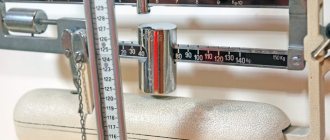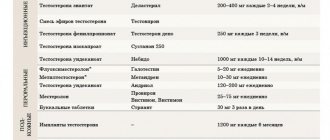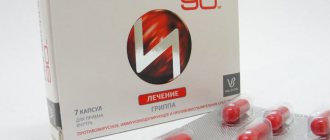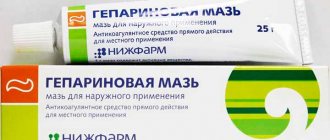pharmachologic effect
Long-acting antihistamine, peripheral histamine H1 receptor blocker. Desloratadine is the primary active metabolite of loratadine. Inhibits the cascade of allergic inflammation reactions, incl. release of proinflammatory cytokines, including interleukins IL-4, IL-6, IL-8, IL-13, release of proinflammatory chemokines, production of superoxide anions by activated polymorphonuclear neutrophils, adhesion and chemotaxis of eosinophils, release of adhesion molecules such as P-selectin, IgE- mediated release of histamine, prostaglandin D2 and leukotriene C4. Thus, it prevents the development and facilitates the course of allergic reactions, has antipruritic and antiexudative effects, reduces capillary permeability, and prevents the development of tissue edema and smooth muscle spasm. The drug has no effect on the central nervous system, has virtually no sedative effect (does not cause drowsiness) and does not affect the speed of psychomotor reactions when taken in recommended doses. Does not cause prolongation of the QT interval on the ECG. The action of desloratadine begins within 30 minutes after oral administration and continues for 24 hours.
How does Dezal work?
The medication belongs to the group of antihistamine receptor blockers, that is, it is intended to suppress a chain of allergic reactions. It acts in the following areas:
- prevents the development of allergy symptoms;
- improves the condition of allergies;
- relieves itching;
- prevents the development of tissue swelling;
- reduces mucus secretion and lacrimation;
- strengthens the walls of small blood vessels;
- serves as a prevention of spasms.
Desal tablets do not inhibit the functioning of the nervous system, have a minimal sedative effect, and if the dosage regimen is followed, they do not provoke lethargy and do not impair the speed of reaction.
The effect of the tablet begins half an hour after taking it. The effect lasts throughout the day.
Pharmacokinetics
Absorption After taking the drug orally, desloratadine is well absorbed from the gastrointestinal tract. Determined in the blood plasma after 30 minutes, and Cmax is reached after approximately 3 hours. No clinically significant changes in the concentration of desloratadine in the blood plasma were observed with repeated doses of ketoconazole and erythromycin. The bioavailability of desloratadine is dose proportional with doses ranging from 5 mg to 20 mg. Distribution Plasma protein binding is 83-87%. When used in adults and adolescents for 14 days at a dose of 5 mg to 20 mg 1 time / day, there are no signs of clinically significant accumulation of desloratadine. The degree of accumulation of desloratadine is consistent with the T1/2 value and the frequency of its use once a day. AUC and Cmax values in children were similar to those in adults receiving 5 mg desloratadine. Simultaneous intake of food or grapefruit juice does not affect the distribution of desloratadine (when taken at a dose of 7.5 mg 1 time / day). Does not penetrate the BBB. Metabolism The enzymes responsible for the metabolism of desloratadine are not yet known, so interactions with certain drugs cannot be completely excluded. It is not an inhibitor of CYP3A4 or CYP2D6 and is not a substrate or inhibitor of P-glycoprotein. Extensively metabolized in the liver by hydroxylation to form 3-OH-desloratadine, which is then glucuronidated. Excretion The terminal phase T1/2 is about 27 hours. Desloratadine is excreted from the body in the form of a glucuronide compound and in small amounts unchanged (with urine - less than 2% and through the intestines - less than 7%).
Reviews, analogues
Doctors' opinions on the Internet about Dezale are mostly positive. The convenience of a single dose, a variety of dosage forms, good tolerability, and speed of action are noted. The drug also helps to reduce swelling in viral diseases of the ENT organs.
Buyers point out the acceptable cost, long-lasting effect, modernity of the drug and lack of addiction as advantages.
Analogues of the active substance include: Erius, Lordestin, Blogir-3, Desloratadine tablets, Ezlor Solution Tablets. The following new generation drugs also have an antihistamine effect: Suprastinex, Zodak Express based on levocetirizine, Allegra and Telfast based on fexofenadine.
Overdose
Symptoms: taking a dose 9 times higher than the recommended dose (45 mg) did not lead to the appearance of any clinically significant symptoms. Drowsiness may develop. Treatment: gastric lavage is necessary, taking activated charcoal; if necessary, symptomatic therapy. Desloratadine is not eliminated by hemodialysis; the effectiveness of peritoneal dialysis has not been established. If a large amount of the drug is accidentally ingested, the patient should immediately consult a doctor.
Important instructions
If it is necessary to operate transport or complex mechanisms, it is necessary to take into account the individual characteristics of the body. In some cases, the drug can cause drowsiness and lethargy, so you need to be careful during hazardous activities.
In case of overdose, severe drowsiness is possible. In this case, it is recommended to rinse the stomach and take activated charcoal. If necessary, symptomatic treatment is prescribed.
Significant interactions with other pharmaceuticals, such as the antibiotic azithromycin, have not been established.
Side effect
The following adverse reactions are most often observed: increased fatigue (1.2%), dry oral mucosa (0.8%), headache (0.6%). When using the drug in adults and adolescents at the recommended dose of 5 mg/day, the incidence of drowsiness is not higher than when using placebo. During post-marketing surveillance, the following adverse reactions were very rarely observed. Mental disorders: hallucinations. From the central nervous system: dizziness, drowsiness, insomnia, psychomotor hyperactivity. From the cardiovascular system: tachycardia, palpitations. From the digestive system: abdominal pain, nausea, vomiting, dyspepsia, diarrhea. From the liver and biliary tract: increased activity of liver enzymes, increased bilirubin concentration, hepatitis. From the musculoskeletal system: myalgia. Allergic reactions: anaphylaxis, angioedema, itching, rash, urticaria.
Desal
Desal solution for oral administration 0.5 mg/ml 100 ml x1, ATX code: R06AX27 (Desloratadine) Active substance: desloratadine (desloratadine) Rec.INN registered by WHO
Dosage form
DEZAL
solution for oral administration 0.5 mg/1 ml: vial. 50ml, 60ml, 100ml, 120ml, 150ml or 300ml included. with measure spoon or dispenser syringe. No.: LP-002258 from 01.10.13 - Valid
Release form, composition and packaging
The solution for oral administration is clear, colorless, free from foreign particles.
1 ml
desloratadine 0.5 mg
Excipients: sorbitol - 147.15 mg, propylene glycol - 102.3 mg, citric acid monohydrate - 21.06 mg, sodium citrate dihydrate - 16.38 mg, hypromellose 2910 - 2 mg, sucralose - 1 mg, disodium edetate - 0.04 mg, tutti-frutti flavoring - 0.03 mg.
Clinical and pharmacological group: Histamine H1 receptor blocker. Antiallergic drug Pharmacotherapeutic group: H1-histamine receptor blocker
pharmachologic effect
Long-acting antihistamine, peripheral histamine H1 receptor blocker. Desloratadine is the primary active metabolite of loratadine. Inhibits the cascade of allergic inflammation reactions, incl. release of proinflammatory cytokines, including interleukins IL-4, IL-6, IL-8, IL-13, release of proinflammatory chemokines, production of superoxide anions by activated polymorphonuclear neutrophils, adhesion and chemotaxis of eosinophils, release of adhesion molecules such as P-selectin, IgE- mediated release of histamine, prostaglandin D2 and leukotriene C4. Thus, the drug prevents the development and facilitates the course of allergic reactions, has antipruritic and antiexudative effects, reduces capillary permeability, and prevents the development of tissue edema and smooth muscle spasm.
The drug has no effect on the central nervous system, has virtually no sedative effect (does not cause drowsiness) and does not affect the speed of psychomotor reactions when taken in recommended doses. Does not cause prolongation of the QT interval on the ECG.
The action of desloratadine begins within 30 minutes after oral administration and continues for 24 hours.
Pharmacokinetics
Taking desloratadine in the form of an oral solution is equivalent to taking it in the form of tablets containing the same amount of active substance.
Suction
After taking the drug orally, desloratadine is well absorbed from the gastrointestinal tract. Determined in the blood plasma after 30 minutes, and Cmax is reached after approximately 3 hours. No clinically significant changes in the concentration of desloratadine in the blood plasma were observed with repeated doses of ketoconazole and erythromycin. The bioavailability of desloratadine is dose proportional with doses ranging from 5 mg to 20 mg.
Distribution
Plasma protein binding is 83-87%. When used in adults and adolescents for 14 days at a dose of 5 mg to 20 mg 1 time / day, there are no signs of clinically significant accumulation of desloratadine. The degree of accumulation of desloratadine is consistent with the T1/2 value and the frequency of its use once a day. AUC and Cmax values in children were similar to those in adults receiving 5 mg desloratadine.
Simultaneous intake of food or grapefruit juice does not affect the distribution of desloratadine (when taken at a dose of 7.5 mg 1 time / day). Does not penetrate the BBB.
Metabolism
The enzymes responsible for the metabolism of desloratadine are not yet known, so interactions with certain drugs cannot be completely excluded. It is not an inhibitor of CYP3A4 or CYP2D6 and is not a substrate or inhibitor of P-glycoprotein. Extensively metabolized in the liver by hydroxylation to form 3-OH-desloratadine, which is then glucuronidated.
Removal
T1/2 is about 27 hours. Desloratadine is excreted from the body in the form of a glucuronide compound and in small amounts unchanged (with urine - less than 2% and through the intestines - less than 7%).
Indications
To relieve or eliminate symptoms:
- allergic rhinitis (sneezing, nasal congestion, rhinorrhea, itchy nose, itchy palate, itching and redness of the eyes, lacrimation),
- urticaria (skin itching, rash).
ICD-10 codes
Dosage regimen
Take orally, regardless of food intake.
Children aged 1 to 5 years - 2.5 ml of solution (1.25 mg) 1 time / day.
Children aged 6 to 11 years - 5 ml of solution (2.5 mg) 1 time / day.
Adults and adolescents (12 years and older) - 10 ml of solution (5 mg) 1 time / day.
Side effect
In children aged 2 to 11 years, the incidence of side effects with desloratadine was the same as with placebo.
In children under 2 years of age, the following side effects were observed when using desloratadine, the frequency of which was slightly higher than when using placebo: diarrhea (3.7%), increased body temperature (2.3%), insomnia (2.3%).
In adults and adolescents aged 12 years and older, the following side effects were observed when using desloratadine, the frequency of which was slightly higher than when using placebo: increased fatigue (1.2%), dry mouth (0.8%), headache (0.6%) .
When using the drug in adults and adolescents at the recommended dose of 5 mg/day, the incidence of drowsiness is not higher than when using placebo.
During post-marketing surveillance, the following adverse reactions were very rarely observed.
Mental disorders: hallucinations.
From the central nervous system: dizziness, drowsiness, insomnia, psychomotor hyperactivity.
From the cardiovascular system: tachycardia, palpitations.
From the digestive system: abdominal pain, nausea, vomiting, dyspepsia, diarrhea.
From the liver and biliary tract: increased activity of liver enzymes, increased bilirubin concentration, hepatitis.
From the musculoskeletal system: myalgia.
Allergic reactions: anaphylaxis, angioedema, itching, rash, urticaria.
Contraindications for use
- hypersensitivity to the active or any excipient of the drug,
- pregnancy,
- lactation period (breastfeeding),
- children under 1 year of age (efficacy and safety have not been established),
- hereditary diseases - fructose intolerance, glucose/galactose malabsorption or sucrase/isomaltase deficiency in the body (due to the presence of sorbitol in the drug).
The drug should be used with caution in severe renal failure.
Use during pregnancy and breastfeeding
Prescription of the drug during pregnancy is contraindicated due to the lack of clinical data on the safety of its use during this period.
Desloratadine is excreted in breast milk, so its use during breastfeeding is contraindicated.
Use for impaired renal function The drug should be used with caution in severe renal failure.
Use in children Contraindicated for use in children under 12 years of age, because efficacy and safety have not been established.
special instructions
The effectiveness and safety of Dezal in children under 1 year of age has not been established.
Differential diagnosis between allergic rhinitis and rhinitis of other origin in children under 2 years of age presents certain difficulties. When making a differential diagnosis, attention should be paid to the presence or absence of foci of infection or structural abnormalities of the upper respiratory tract, a thorough history, examination, and appropriate laboratory tests and skin tests.
Approximately 6% of adults and children aged 2 to 11 years have a low ability to metabolize desloratadine, and desloratadine is eliminated more slowly in this group of patients. The safety profile of desloratadine in children aged 2 to 11 years with low metabolic rates is similar to that in children with normal metabolism of desloratadine. The effect of desloratadine in children under 2 years of age with a low metabolic rate has not been studied.
In case of severe renal impairment, Dezal should be taken with caution.
Impact on the ability to drive vehicles and machinery
In studies of the effect of desloratadine on the ability to drive vehicles, no impairment of concentration was observed. However, it should be borne in mind that very rarely some patients may develop drowsiness; in this case, care should be taken when driving vehicles and when working with machinery.
Overdose
Symptoms: taking a dose 9 times higher than the recommended dose (45 mg) did not lead to the appearance of any clinically significant symptoms. Drowsiness may develop.
Treatment: gastric lavage, activated carbon, and, if necessary, symptomatic therapy. Desloratadine is not eliminated by hemodialysis; the effectiveness of peritoneal dialysis has not been established.
If a large amount of the drug is accidentally ingested, the patient should immediately consult a doctor.
Drug interactions
No clinically significant interactions with other drugs have been identified (including ketoconazole and erythromycin).
Desloratadine does not enhance the effect of ethanol on the central nervous system.
Storage conditions and periods
The drug should be stored out of the reach of children at a temperature not exceeding 25°C. Shelf life: 3 years.
Conditions for dispensing from pharmacies The drug is approved for use as an over-the-counter product.
Release form
Blue film-coated tablets, round, biconvex, with “LT” engraved on one side. 1 tab. Active substance: desloratadine 5 mg; Excipients: microcrystalline cellulose - 55 mg, pregelatinized corn starch - 15 mg, mannitol - 22 mg, talc - 2.5 mg, magnesium stearate - 0.5 mg. Film shell composition: opadry blue 03F20404 (hypromellose 6cP - 1.9 mg, titanium dioxide (E171) - 0.61 mg, macrogol 6000 - 0.34 mg, dye indigo carmine aluminum varnish (E132) - 0.14 mg) - about 3 mg. 10 pieces. - blisters (1) - cardboard packs. 10 pieces. - blisters (2) - cardboard packs. 10 pieces. - blisters (3) - cardboard packs.
Description of drug types
Desal is available in the form of tablets and oral solution. The main active ingredient in both cases is desloratadine.
The tablets have a blue film shell and a round, biconvex shape. One piece contains 5 mg of desloratadine. Additionally, the composition includes: magnesium stearate, cellulose, corn starch and mannitol.
The tablets are packaged in cell plates of 10 pieces, and go on sale in cardboard boxes of 10 or 30 pieces.
The liquid form is presented as a clear, colorless solution with a fruity aroma and sour taste; 1 ml contains 0.5 mg of desloratadine. Sold in 100 ml bottles complete with a measuring syringe and instructions, which are placed in a box.










